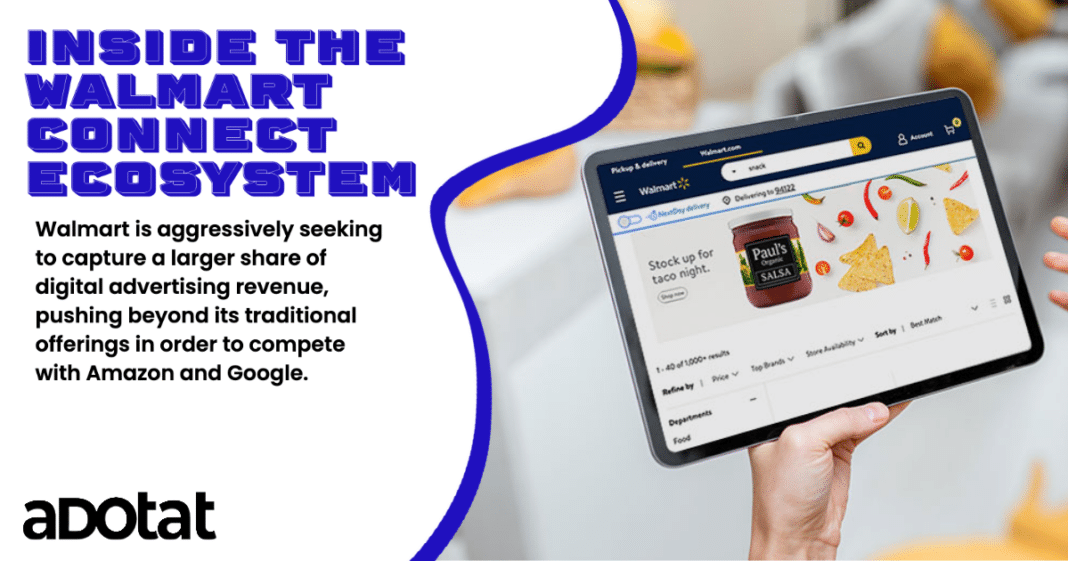Walmart reported higher earnings in its third quarter this week. All revenue increased by 30% between the second and third quarters, but that’s only part of the story: Walmart U.S.’ advertising sales have grown 40% year-over-year—a sign brands are increasingly looking to online channels as a way to reach their customers more efficiently than ever before.
Walmart is aggressively seeking to capture a larger share of digital advertising revenue, pushing beyond its traditional offerings in order to compete with Amazon and Google.
Although Walmart continues to trail Amazon in areas such as content creation and distribution, the company is making large investments into strategic opportunities—such as product improvements or customer experience upgrades —and showing its commitment to being a serious player in the eCommerce ad market.
On a recent earnings call, President and CEO Doug McMillon attributed the growth to “More items and sellers driving GMV (Gross Merchandise Volume) and improving customer satisfaction.”
He continued that success with advertising is “mutually reinforcing. If we double-click on advertising with Walmart Connect in the U.S., we see it benefiting from growth in e-commerce and improvements made within the business itself. And we’ve seen strong growth in return on ad spend over last year.”
Walmart Connect, the U.S. advertising division of the big-box store, grew 40% year-on-year in the company’s fiscal third quarter, according to an earnings statement. Walmart Connect is Walmart’s self-service ad platform that was recently announced; it allows retailers to create an account and upload their product SKUs to the Walmart platform.
CEO Doug McMillon told investors that their flywheel continues to take shape, as omnichannel approaches like marketplace, advertising, and fulfillment strengthen the core business. The latter posted a consecutive quarter ad sales growth of 30%.
The aim, explained CFO John David Rainey, was to build out parts of the business like advertising and fulfillment, which are not only faster-growing but have a higher margin associated with them.
What does this flywheel contain?
For instance, Walmart just announced that it will be offering the Paramount+ ad-supported tier—which previously cost $5 per month as a standalone subscription—free to all Walmart+ members. And there is another benefit to Walmart Connect: It will secure a guaranteed chunk of the premium CTV inventory it can package on its own ad platform.
Walmart’s investment in its advertising platform has another, equally important motivation: the fact that it is a high-margin revenue source. This is the area where Walmart’s leadership has been most aggressive.
The company has been investing in its advertising business for years, and it now sells more than $1 billion worth of ads per quarter. All that investment has paid off: Walmart’s e-commerce business is growing at twice the rate of Amazon, which means it could quickly become a bigger threat if not addressed.
McMillon told ADOTAT that Walmart is trying to leverage the relationship between digital growth, marketplace expansion and advertising.
However, many other companies are also benefiting from Walmart’s new ecosystem Walmart recently announced it has added several new API partners to its Walmart Connect retail media network.
The company has focused on adding features and capabilities by partnering with technology and service vendors.
Earlier this summer, it struck deals with several ad-tech vendors— all of them specialists in different areas such as ecommerce ads, ad optimization ,and cross-channel advertising.
The partnerships are in addition to the previously announced integration with the e-commerce platform CommerceIQ. Partnering with ad optimization platform Intentwise, e-commerce ad platform Perpetua and e-commerce cross-channel targeting service Quartile, Sellozo provides advertisers with a range of options to customize their ads.
The platform also announced new deals that aim to better measure the impact of social commerce on TikTok and Snap, as well as CTV ads running on Roku. Walmart is also working with live video commerce platforms Firework and TalkShopLive to develop content around live-shopping events for its website.
Advertisers will soon be able to use new platforms and technologies in the ad tech, measurement and e-commerce industries.
Beyond the retailer’s owned and operated channels, Walmart Connect allows advertisers to reach other trafficking platforms such as those of The Trade Desk—a partnership that was launched in 2021
In addition to partnering with The Trade Desk, Walmart has acquired ad tech company Thunder for their creative automation and ad optimization capabilities. This will provide the company’s coming demand-side platform (DSP) with enhanced features that are similar in vein to Amazon acquiring Sizmek last year.
Colgate-Palmolive was able to use Walmart Onsite and Offsite Display through the recommendations of Walmart Connect’s campaign platform to drive 30% in new buyers for its dorm essentials range, with an 8% sales lift and $11.16 return on ad spend.
This past October, it launched its Walmart Creator platform. The portal allows content creators to make a commission — with no limit — on any product links shared on social media sites like Facebook and Instagram. Walmart Creator provides users with product recommendations based on their interests. The program also tracks the performance of each user’s campaigns and provides them with data to help improve future advertising efforts, according to the release.
Walmart serves more than 230 million customers and members each week at its more than 10,500 stores and on numerous e-commerce websites. Walmart is making an astute move by expanding the range of products and services it advertises. Walmart has unparalleled insights into how US consumers shop, and will become a major player in the ad industry moving forward.




